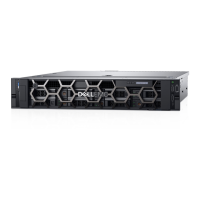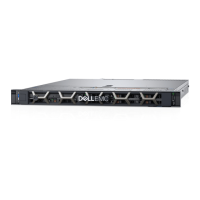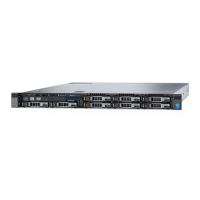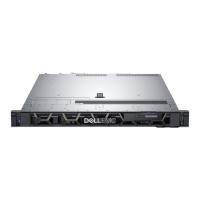Item Indicator, button, or
connector
Icon Description
also congure iDRAC, BIOS, and networking parameters. You can also
launch the virtual Keyboard, Video, and Mouse (KVM) viewer and
virtual Kernel based Virtual Machine (KVM), on a supported mobile
device. For more information, see the Integrated Dell Remote Access
Controller User's Guide at Dell.com/poweredgemanuals.
Status LED indicators
NOTE: The indicators display solid amber if any error occurs.
Table 5. Status LED indicators and descriptions
Icon Description Condition Corrective action
Drive
indicator
The indicator turns solid amber if
there is a drive error.
• Check the System Event Log to determine if the drive has an error.
• Run the appropriate Online Diagnostics test. Restart the system and
run embedded diagnostics (ePSA).
• If the drives are congured in a RAID array, restart the system, and
enter the host adapter conguration utility program.
Temperature
indicator
The indicator turns solid amber if
the system experiences a thermal
error (for example, the ambient
temperature is out of range or
there is a fan failure).
Ensure that none of the following conditions exist:
• A cooling fan has been removed or has failed.
• System cover, air shroud, memory module blank, or back ller bracket is
removed.
• Ambient temperature is too high.
• External airow is obstructed.
If the problem persists, see Getting help.
Electrical
indicator
The indicator turns solid amber if
the system experiences an
electrical error (for example,
voltage out of range, or a failed
power supply unit (PSU) or voltage
regulator).
Check the System Event Log or system messages for the specic issue. If
it is due to a problem with the PSU, check the LED on the PSU. Reseat the
PSU.
If the problem persists, see Getting help.
Memory
indicator
The indicator turns solid amber if a
memory error occurs.
Check the System Event Log or system messages for the location of the
failed memory. Reseat the memory module.
If the problem persists, see Getting help.
PCIe
indicator
The indicator turns solid amber if a
PCIe card experiences an error.
Restart the system. Update any required drivers for the PCIe card. Reinstall
the card.
If the problem persists, see Getting help.
NOTE: For more information about the supported PCIe cards, see
Expansion card installation guidelines.
PowerEdge R740 system overview 13

